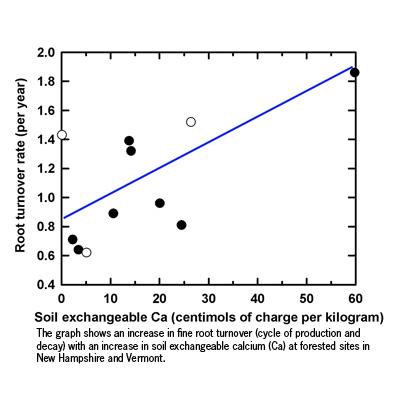Cross-site Comparison of Nutrient Cycling and Root Dynamics along a Calcium Supply Gradient

Calcium is a critical plant nutrient found in forest soils. Acidic deposition causes leaching of calcium out of soil and can free up aluminum, which can make calcium unavailable for plant uptake. NSRC researchers studied hardwood and coniferous forests under contrasting conditions of soil calcium at three sites: Hubbard Brook and Cone Pond in New Hampshire and Sleepers River in Vermont. Researchers combined existing data and new measurements to compute annual nutrient (nitrogen, phosphorus, sulfur, calcium, magnesium, and potassium) fluctuations in throughfall (water falling from leaves), leaf litterfall, and aboveground biomass, as well as to account for the belowground biomass component. The major new effort in this project was directed at measurements of root turnover, or cycle of production and decay.
Neither aboveground biomass and production nor belowground biomass was related to soil calcium or calcium:aluminum ratios in any of the soil calcium conditions. Hardwood stands had 37% greater aboveground biomass and 44% greater leaf litter production than conifer stands, on average. Fine root biomass (less than 2 mm in diameter) in the upper 35 cm of the soil, including the forest floor, was very similar in hardwoods and conifers (5.92 and 5.93 milligrams per hectare).
The turnover of fine roots increased significantly with soil exchangeable calcium. As a result, calculated fine root production was clearly greater in sites with higher soil calcium in both hardwood and conifer stands. The relationship between soil calcium availability and root production suggests that calcium and other cation depletion might lead to reduced carbon allocation to roots in these ecosystems.
